MKT201 Integrated Marketing Communications: Coca-Cola Analysis
VerifiedAdded on 2023/06/13
|8
|1622
|275
Report
AI Summary
This report provides an analysis of Coca-Cola's integrated marketing communications (IMC) strategies. It identifies and analyzes the company's use of various marketing tactics to promote its products, including communication processes, persuasion strategies, market segmentation, and brand positioning techniques. The report delves into Coca-Cola's SWOT analysis, differentiation strategy, and segmentation approaches based on behavioral, psychoanalytic, and profile aspects. Furthermore, it examines the seven tools of persuasion employed by the company in its marketing process, such as reciprocation, commitment and consistency, social proof, liking, authority, and scarcity. The analysis also covers Coca-Cola's current advertising strategy, which focuses on comparative advertising and incorporates music and humor. Finally, the report highlights the company's current IMC practices, including web advertising, direct marketing, and print, digital, and electronic media, which have helped build the brand and maintain its market share. This document is available on Desklib, a platform offering study tools and resources for students.
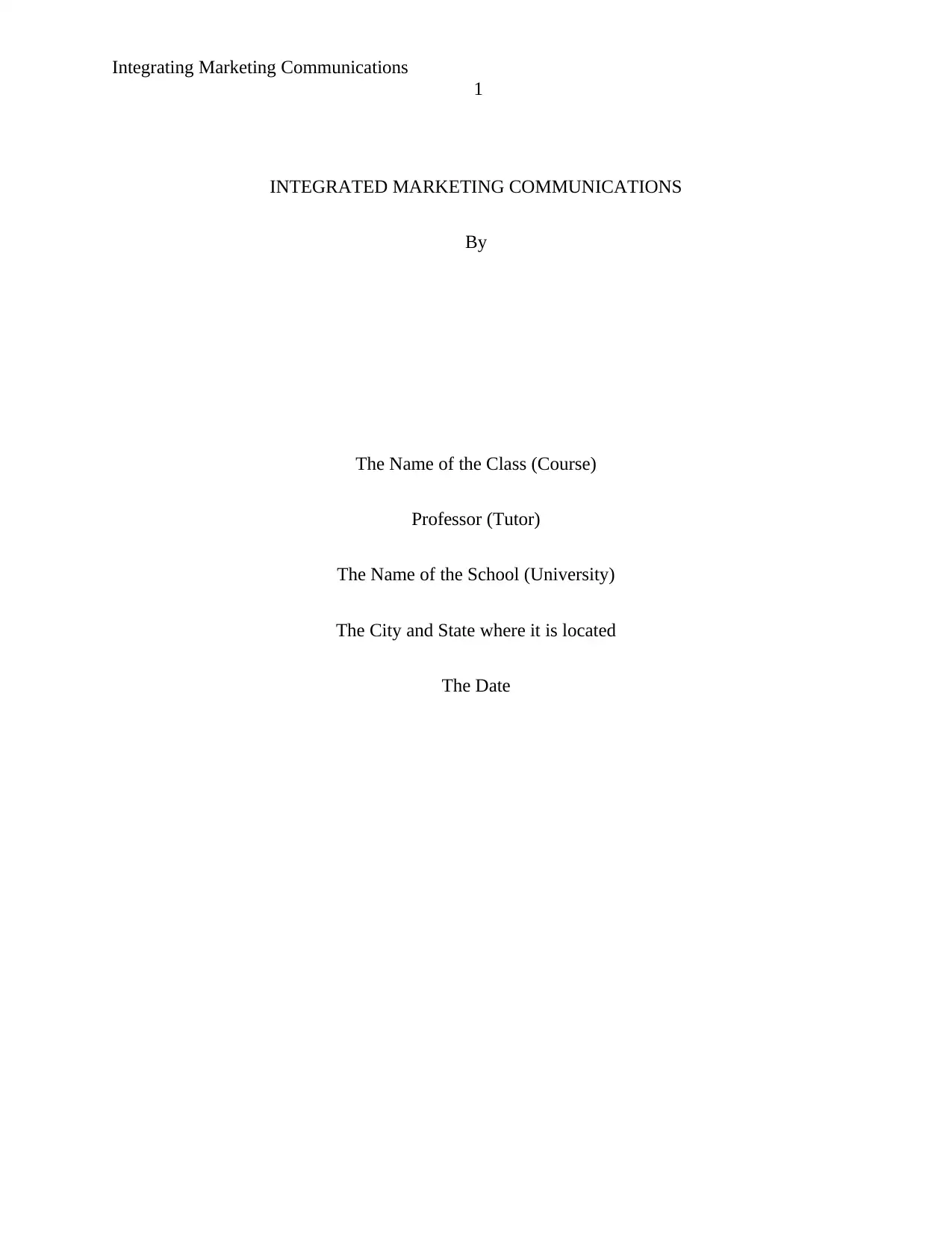
Integrating Marketing Communications
1
INTEGRATED MARKETING COMMUNICATIONS
By
The Name of the Class (Course)
Professor (Tutor)
The Name of the School (University)
The City and State where it is located
The Date
1
INTEGRATED MARKETING COMMUNICATIONS
By
The Name of the Class (Course)
Professor (Tutor)
The Name of the School (University)
The City and State where it is located
The Date
Paraphrase This Document
Need a fresh take? Get an instant paraphrase of this document with our AI Paraphraser
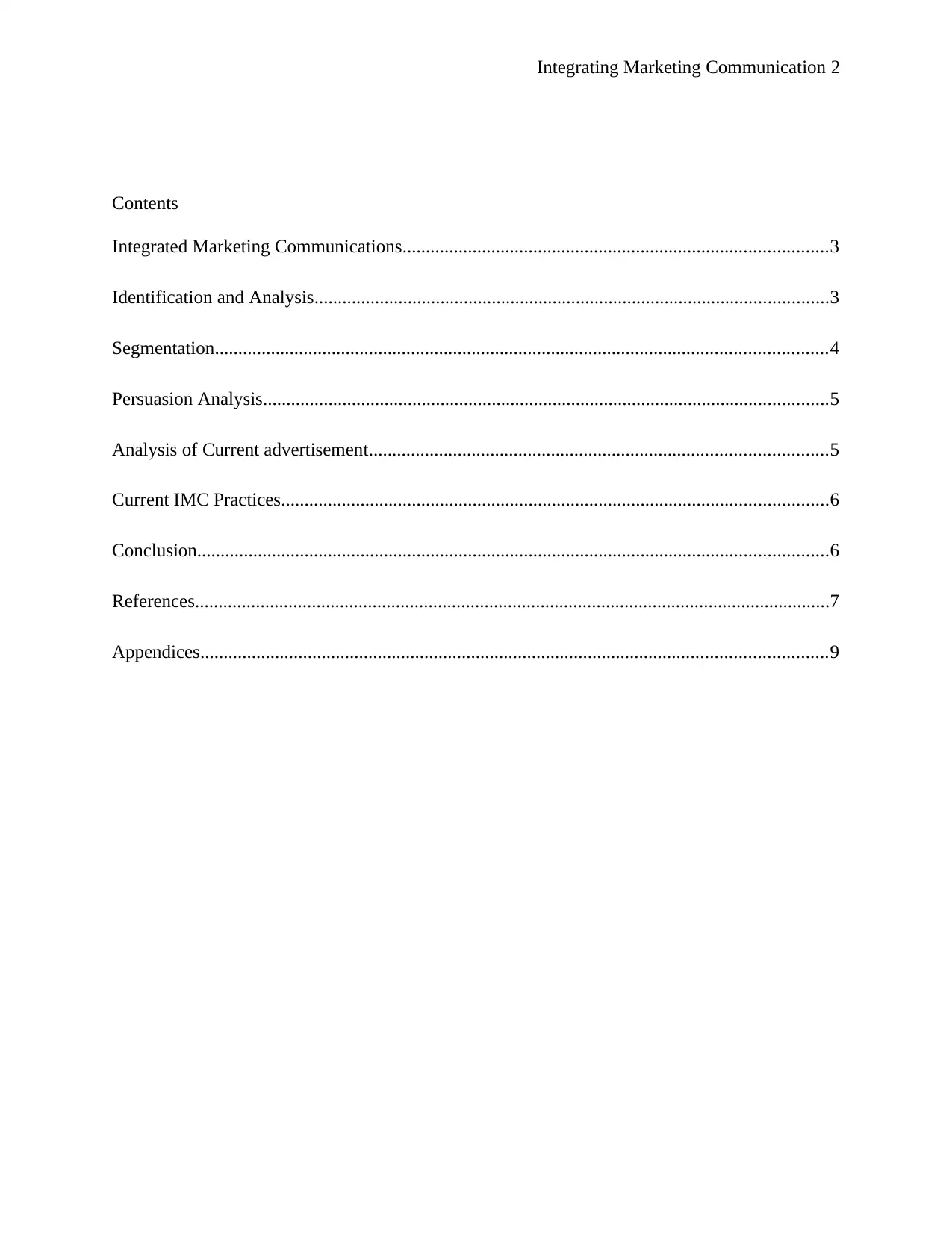
Integrating Marketing Communication 2
Contents
Integrated Marketing Communications...........................................................................................3
Identification and Analysis..............................................................................................................3
Segmentation...................................................................................................................................4
Persuasion Analysis.........................................................................................................................5
Analysis of Current advertisement..................................................................................................5
Current IMC Practices.....................................................................................................................6
Conclusion.......................................................................................................................................6
References........................................................................................................................................7
Appendices......................................................................................................................................9
Contents
Integrated Marketing Communications...........................................................................................3
Identification and Analysis..............................................................................................................3
Segmentation...................................................................................................................................4
Persuasion Analysis.........................................................................................................................5
Analysis of Current advertisement..................................................................................................5
Current IMC Practices.....................................................................................................................6
Conclusion.......................................................................................................................................6
References........................................................................................................................................7
Appendices......................................................................................................................................9
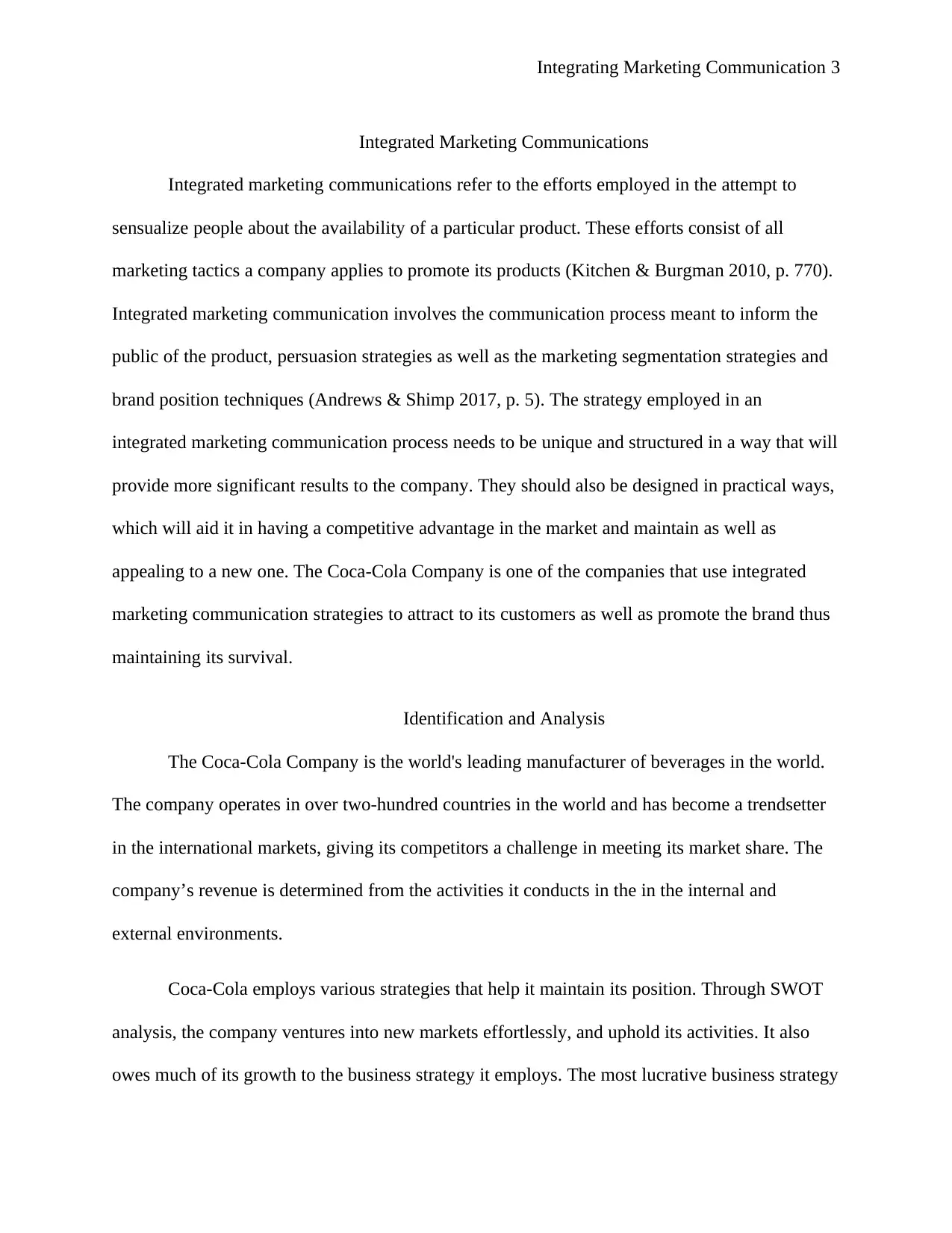
Integrating Marketing Communication 3
Integrated Marketing Communications
Integrated marketing communications refer to the efforts employed in the attempt to
sensualize people about the availability of a particular product. These efforts consist of all
marketing tactics a company applies to promote its products (Kitchen & Burgman 2010, p. 770).
Integrated marketing communication involves the communication process meant to inform the
public of the product, persuasion strategies as well as the marketing segmentation strategies and
brand position techniques (Andrews & Shimp 2017, p. 5). The strategy employed in an
integrated marketing communication process needs to be unique and structured in a way that will
provide more significant results to the company. They should also be designed in practical ways,
which will aid it in having a competitive advantage in the market and maintain as well as
appealing to a new one. The Coca-Cola Company is one of the companies that use integrated
marketing communication strategies to attract to its customers as well as promote the brand thus
maintaining its survival.
Identification and Analysis
The Coca-Cola Company is the world's leading manufacturer of beverages in the world.
The company operates in over two-hundred countries in the world and has become a trendsetter
in the international markets, giving its competitors a challenge in meeting its market share. The
company’s revenue is determined from the activities it conducts in the in the internal and
external environments.
Coca-Cola employs various strategies that help it maintain its position. Through SWOT
analysis, the company ventures into new markets effortlessly, and uphold its activities. It also
owes much of its growth to the business strategy it employs. The most lucrative business strategy
Integrated Marketing Communications
Integrated marketing communications refer to the efforts employed in the attempt to
sensualize people about the availability of a particular product. These efforts consist of all
marketing tactics a company applies to promote its products (Kitchen & Burgman 2010, p. 770).
Integrated marketing communication involves the communication process meant to inform the
public of the product, persuasion strategies as well as the marketing segmentation strategies and
brand position techniques (Andrews & Shimp 2017, p. 5). The strategy employed in an
integrated marketing communication process needs to be unique and structured in a way that will
provide more significant results to the company. They should also be designed in practical ways,
which will aid it in having a competitive advantage in the market and maintain as well as
appealing to a new one. The Coca-Cola Company is one of the companies that use integrated
marketing communication strategies to attract to its customers as well as promote the brand thus
maintaining its survival.
Identification and Analysis
The Coca-Cola Company is the world's leading manufacturer of beverages in the world.
The company operates in over two-hundred countries in the world and has become a trendsetter
in the international markets, giving its competitors a challenge in meeting its market share. The
company’s revenue is determined from the activities it conducts in the in the internal and
external environments.
Coca-Cola employs various strategies that help it maintain its position. Through SWOT
analysis, the company ventures into new markets effortlessly, and uphold its activities. It also
owes much of its growth to the business strategy it employs. The most lucrative business strategy
⊘ This is a preview!⊘
Do you want full access?
Subscribe today to unlock all pages.

Trusted by 1+ million students worldwide
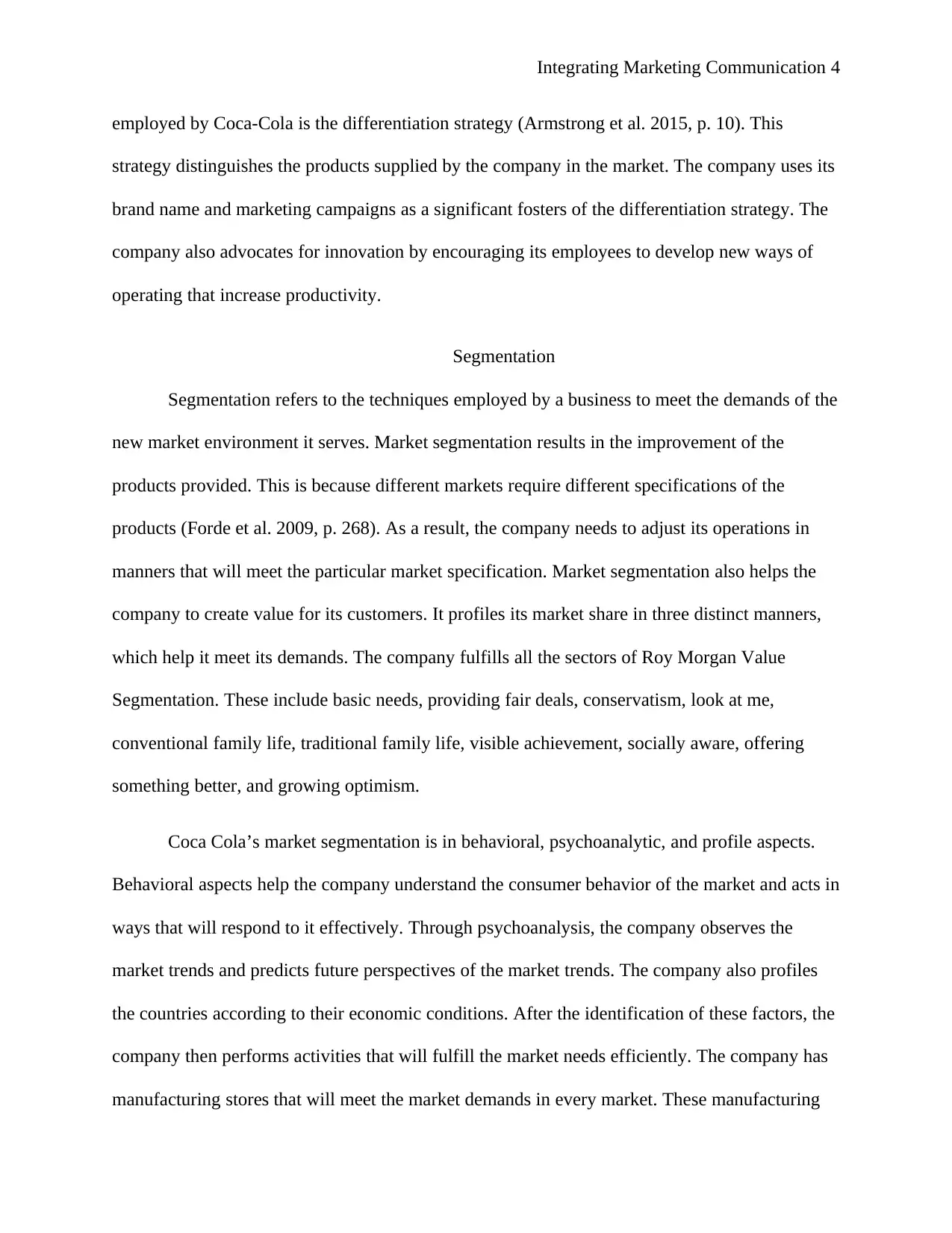
Integrating Marketing Communication 4
employed by Coca-Cola is the differentiation strategy (Armstrong et al. 2015, p. 10). This
strategy distinguishes the products supplied by the company in the market. The company uses its
brand name and marketing campaigns as a significant fosters of the differentiation strategy. The
company also advocates for innovation by encouraging its employees to develop new ways of
operating that increase productivity.
Segmentation
Segmentation refers to the techniques employed by a business to meet the demands of the
new market environment it serves. Market segmentation results in the improvement of the
products provided. This is because different markets require different specifications of the
products (Forde et al. 2009, p. 268). As a result, the company needs to adjust its operations in
manners that will meet the particular market specification. Market segmentation also helps the
company to create value for its customers. It profiles its market share in three distinct manners,
which help it meet its demands. The company fulfills all the sectors of Roy Morgan Value
Segmentation. These include basic needs, providing fair deals, conservatism, look at me,
conventional family life, traditional family life, visible achievement, socially aware, offering
something better, and growing optimism.
Coca Cola’s market segmentation is in behavioral, psychoanalytic, and profile aspects.
Behavioral aspects help the company understand the consumer behavior of the market and acts in
ways that will respond to it effectively. Through psychoanalysis, the company observes the
market trends and predicts future perspectives of the market trends. The company also profiles
the countries according to their economic conditions. After the identification of these factors, the
company then performs activities that will fulfill the market needs efficiently. The company has
manufacturing stores that will meet the market demands in every market. These manufacturing
employed by Coca-Cola is the differentiation strategy (Armstrong et al. 2015, p. 10). This
strategy distinguishes the products supplied by the company in the market. The company uses its
brand name and marketing campaigns as a significant fosters of the differentiation strategy. The
company also advocates for innovation by encouraging its employees to develop new ways of
operating that increase productivity.
Segmentation
Segmentation refers to the techniques employed by a business to meet the demands of the
new market environment it serves. Market segmentation results in the improvement of the
products provided. This is because different markets require different specifications of the
products (Forde et al. 2009, p. 268). As a result, the company needs to adjust its operations in
manners that will meet the particular market specification. Market segmentation also helps the
company to create value for its customers. It profiles its market share in three distinct manners,
which help it meet its demands. The company fulfills all the sectors of Roy Morgan Value
Segmentation. These include basic needs, providing fair deals, conservatism, look at me,
conventional family life, traditional family life, visible achievement, socially aware, offering
something better, and growing optimism.
Coca Cola’s market segmentation is in behavioral, psychoanalytic, and profile aspects.
Behavioral aspects help the company understand the consumer behavior of the market and acts in
ways that will respond to it effectively. Through psychoanalysis, the company observes the
market trends and predicts future perspectives of the market trends. The company also profiles
the countries according to their economic conditions. After the identification of these factors, the
company then performs activities that will fulfill the market needs efficiently. The company has
manufacturing stores that will meet the market demands in every market. These manufacturing
Paraphrase This Document
Need a fresh take? Get an instant paraphrase of this document with our AI Paraphraser
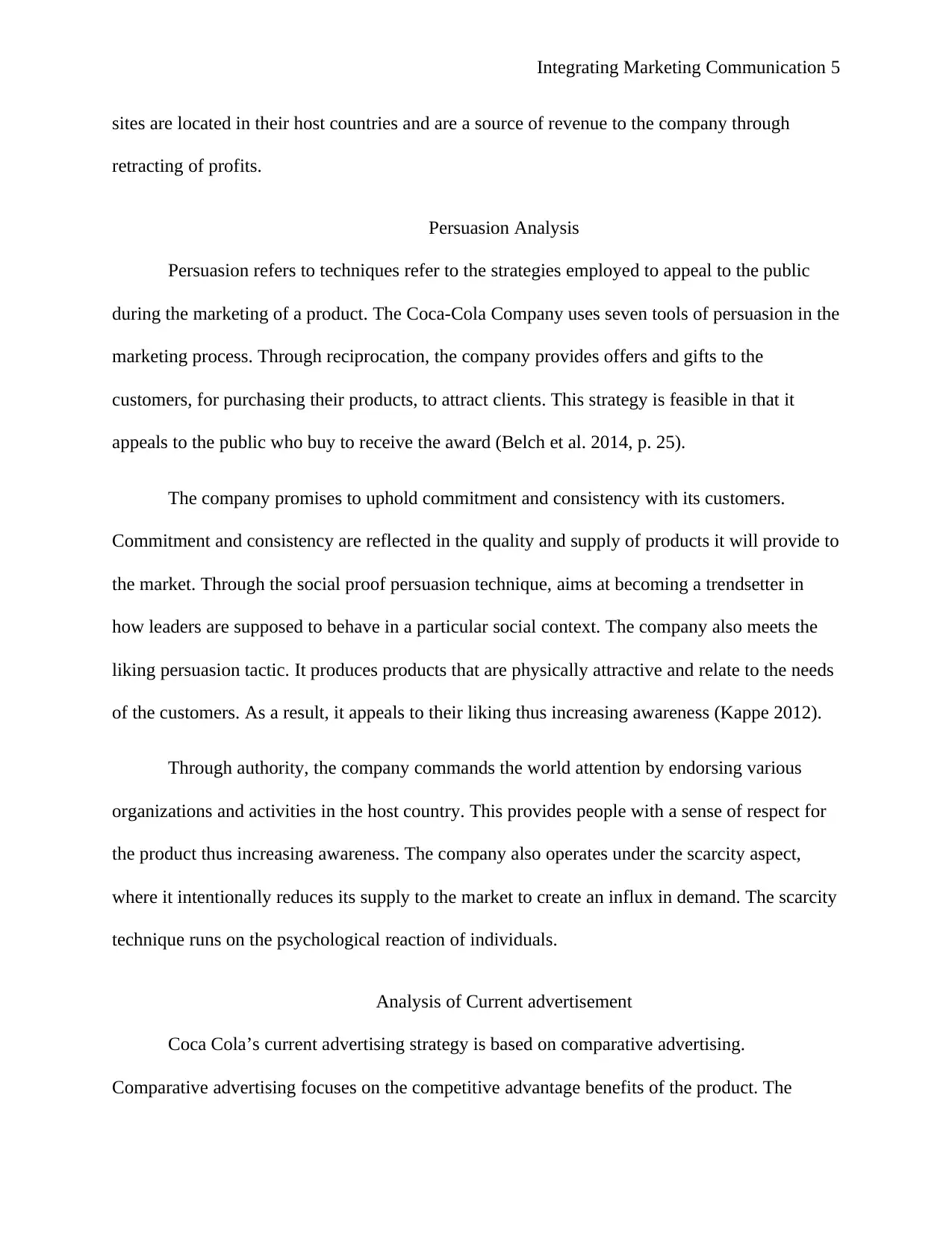
Integrating Marketing Communication 5
sites are located in their host countries and are a source of revenue to the company through
retracting of profits.
Persuasion Analysis
Persuasion refers to techniques refer to the strategies employed to appeal to the public
during the marketing of a product. The Coca-Cola Company uses seven tools of persuasion in the
marketing process. Through reciprocation, the company provides offers and gifts to the
customers, for purchasing their products, to attract clients. This strategy is feasible in that it
appeals to the public who buy to receive the award (Belch et al. 2014, p. 25).
The company promises to uphold commitment and consistency with its customers.
Commitment and consistency are reflected in the quality and supply of products it will provide to
the market. Through the social proof persuasion technique, aims at becoming a trendsetter in
how leaders are supposed to behave in a particular social context. The company also meets the
liking persuasion tactic. It produces products that are physically attractive and relate to the needs
of the customers. As a result, it appeals to their liking thus increasing awareness (Kappe 2012).
Through authority, the company commands the world attention by endorsing various
organizations and activities in the host country. This provides people with a sense of respect for
the product thus increasing awareness. The company also operates under the scarcity aspect,
where it intentionally reduces its supply to the market to create an influx in demand. The scarcity
technique runs on the psychological reaction of individuals.
Analysis of Current advertisement
Coca Cola’s current advertising strategy is based on comparative advertising.
Comparative advertising focuses on the competitive advantage benefits of the product. The
sites are located in their host countries and are a source of revenue to the company through
retracting of profits.
Persuasion Analysis
Persuasion refers to techniques refer to the strategies employed to appeal to the public
during the marketing of a product. The Coca-Cola Company uses seven tools of persuasion in the
marketing process. Through reciprocation, the company provides offers and gifts to the
customers, for purchasing their products, to attract clients. This strategy is feasible in that it
appeals to the public who buy to receive the award (Belch et al. 2014, p. 25).
The company promises to uphold commitment and consistency with its customers.
Commitment and consistency are reflected in the quality and supply of products it will provide to
the market. Through the social proof persuasion technique, aims at becoming a trendsetter in
how leaders are supposed to behave in a particular social context. The company also meets the
liking persuasion tactic. It produces products that are physically attractive and relate to the needs
of the customers. As a result, it appeals to their liking thus increasing awareness (Kappe 2012).
Through authority, the company commands the world attention by endorsing various
organizations and activities in the host country. This provides people with a sense of respect for
the product thus increasing awareness. The company also operates under the scarcity aspect,
where it intentionally reduces its supply to the market to create an influx in demand. The scarcity
technique runs on the psychological reaction of individuals.
Analysis of Current advertisement
Coca Cola’s current advertising strategy is based on comparative advertising.
Comparative advertising focuses on the competitive advantage benefits of the product. The
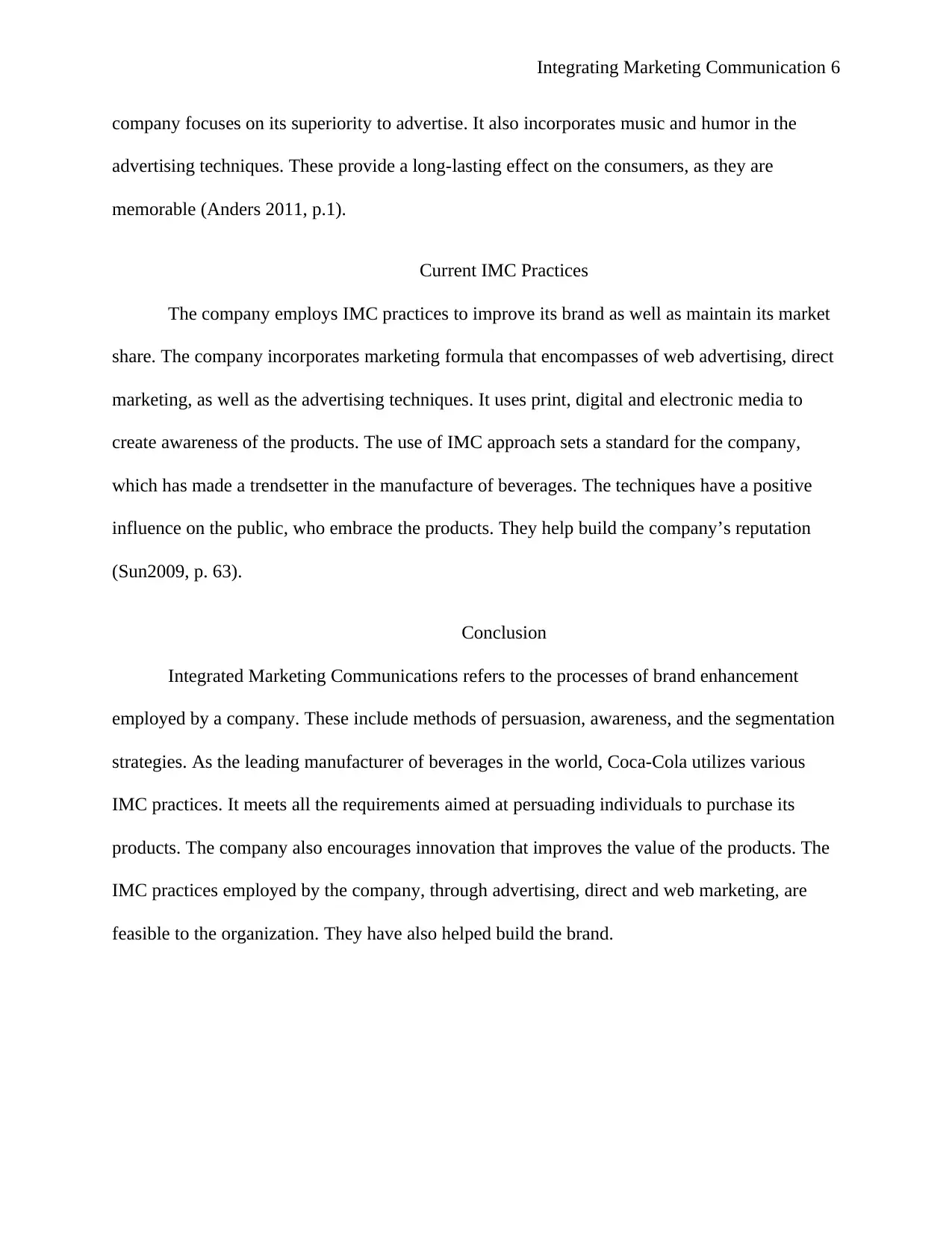
Integrating Marketing Communication 6
company focuses on its superiority to advertise. It also incorporates music and humor in the
advertising techniques. These provide a long-lasting effect on the consumers, as they are
memorable (Anders 2011, p.1).
Current IMC Practices
The company employs IMC practices to improve its brand as well as maintain its market
share. The company incorporates marketing formula that encompasses of web advertising, direct
marketing, as well as the advertising techniques. It uses print, digital and electronic media to
create awareness of the products. The use of IMC approach sets a standard for the company,
which has made a trendsetter in the manufacture of beverages. The techniques have a positive
influence on the public, who embrace the products. They help build the company’s reputation
(Sun2009, p. 63).
Conclusion
Integrated Marketing Communications refers to the processes of brand enhancement
employed by a company. These include methods of persuasion, awareness, and the segmentation
strategies. As the leading manufacturer of beverages in the world, Coca-Cola utilizes various
IMC practices. It meets all the requirements aimed at persuading individuals to purchase its
products. The company also encourages innovation that improves the value of the products. The
IMC practices employed by the company, through advertising, direct and web marketing, are
feasible to the organization. They have also helped build the brand.
company focuses on its superiority to advertise. It also incorporates music and humor in the
advertising techniques. These provide a long-lasting effect on the consumers, as they are
memorable (Anders 2011, p.1).
Current IMC Practices
The company employs IMC practices to improve its brand as well as maintain its market
share. The company incorporates marketing formula that encompasses of web advertising, direct
marketing, as well as the advertising techniques. It uses print, digital and electronic media to
create awareness of the products. The use of IMC approach sets a standard for the company,
which has made a trendsetter in the manufacture of beverages. The techniques have a positive
influence on the public, who embrace the products. They help build the company’s reputation
(Sun2009, p. 63).
Conclusion
Integrated Marketing Communications refers to the processes of brand enhancement
employed by a company. These include methods of persuasion, awareness, and the segmentation
strategies. As the leading manufacturer of beverages in the world, Coca-Cola utilizes various
IMC practices. It meets all the requirements aimed at persuading individuals to purchase its
products. The company also encourages innovation that improves the value of the products. The
IMC practices employed by the company, through advertising, direct and web marketing, are
feasible to the organization. They have also helped build the brand.
⊘ This is a preview!⊘
Do you want full access?
Subscribe today to unlock all pages.

Trusted by 1+ million students worldwide
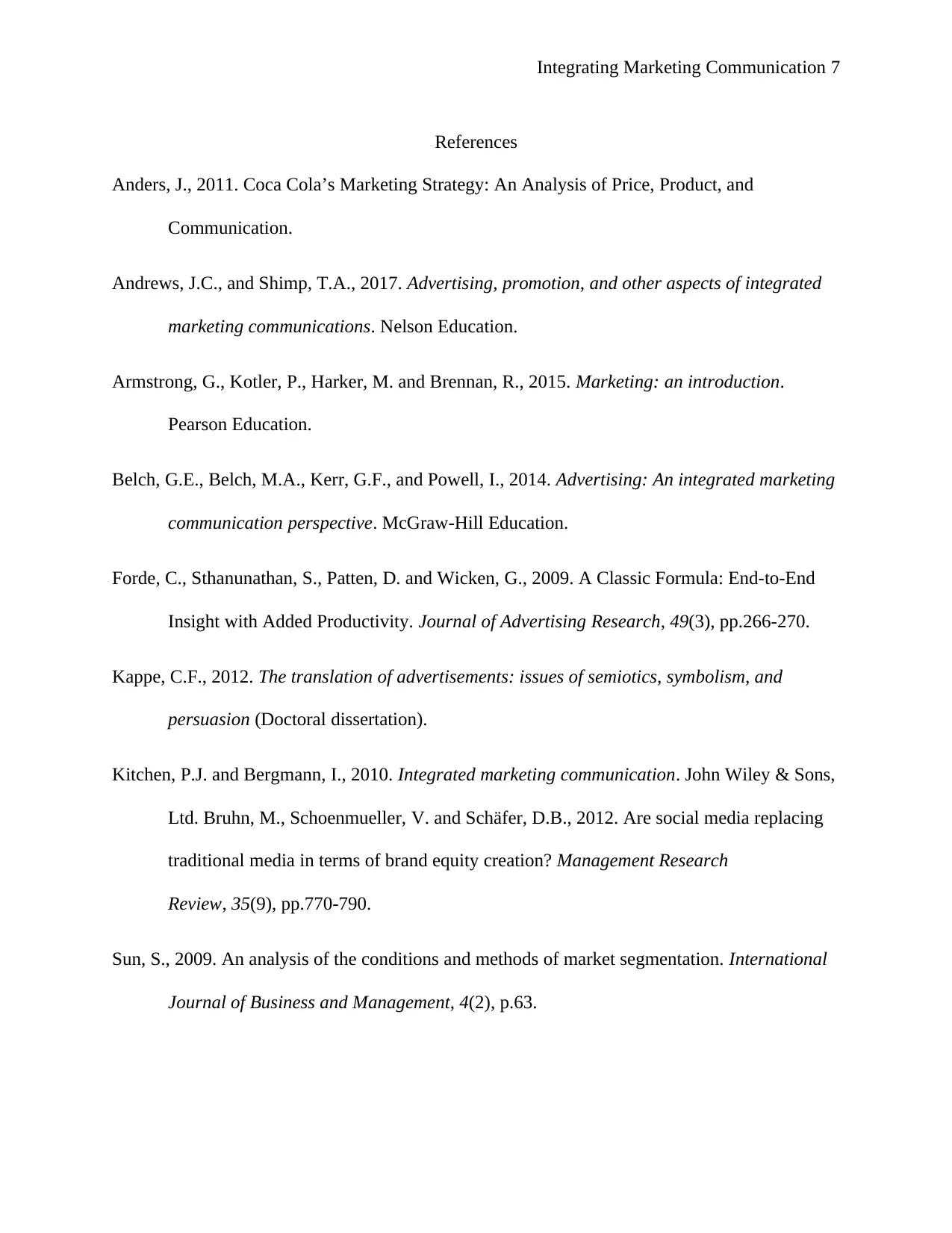
Integrating Marketing Communication 7
References
Anders, J., 2011. Coca Cola’s Marketing Strategy: An Analysis of Price, Product, and
Communication.
Andrews, J.C., and Shimp, T.A., 2017. Advertising, promotion, and other aspects of integrated
marketing communications. Nelson Education.
Armstrong, G., Kotler, P., Harker, M. and Brennan, R., 2015. Marketing: an introduction.
Pearson Education.
Belch, G.E., Belch, M.A., Kerr, G.F., and Powell, I., 2014. Advertising: An integrated marketing
communication perspective. McGraw-Hill Education.
Forde, C., Sthanunathan, S., Patten, D. and Wicken, G., 2009. A Classic Formula: End-to-End
Insight with Added Productivity. Journal of Advertising Research, 49(3), pp.266-270.
Kappe, C.F., 2012. The translation of advertisements: issues of semiotics, symbolism, and
persuasion (Doctoral dissertation).
Kitchen, P.J. and Bergmann, I., 2010. Integrated marketing communication. John Wiley & Sons,
Ltd. Bruhn, M., Schoenmueller, V. and Schäfer, D.B., 2012. Are social media replacing
traditional media in terms of brand equity creation? Management Research
Review, 35(9), pp.770-790.
Sun, S., 2009. An analysis of the conditions and methods of market segmentation. International
Journal of Business and Management, 4(2), p.63.
References
Anders, J., 2011. Coca Cola’s Marketing Strategy: An Analysis of Price, Product, and
Communication.
Andrews, J.C., and Shimp, T.A., 2017. Advertising, promotion, and other aspects of integrated
marketing communications. Nelson Education.
Armstrong, G., Kotler, P., Harker, M. and Brennan, R., 2015. Marketing: an introduction.
Pearson Education.
Belch, G.E., Belch, M.A., Kerr, G.F., and Powell, I., 2014. Advertising: An integrated marketing
communication perspective. McGraw-Hill Education.
Forde, C., Sthanunathan, S., Patten, D. and Wicken, G., 2009. A Classic Formula: End-to-End
Insight with Added Productivity. Journal of Advertising Research, 49(3), pp.266-270.
Kappe, C.F., 2012. The translation of advertisements: issues of semiotics, symbolism, and
persuasion (Doctoral dissertation).
Kitchen, P.J. and Bergmann, I., 2010. Integrated marketing communication. John Wiley & Sons,
Ltd. Bruhn, M., Schoenmueller, V. and Schäfer, D.B., 2012. Are social media replacing
traditional media in terms of brand equity creation? Management Research
Review, 35(9), pp.770-790.
Sun, S., 2009. An analysis of the conditions and methods of market segmentation. International
Journal of Business and Management, 4(2), p.63.
Paraphrase This Document
Need a fresh take? Get an instant paraphrase of this document with our AI Paraphraser
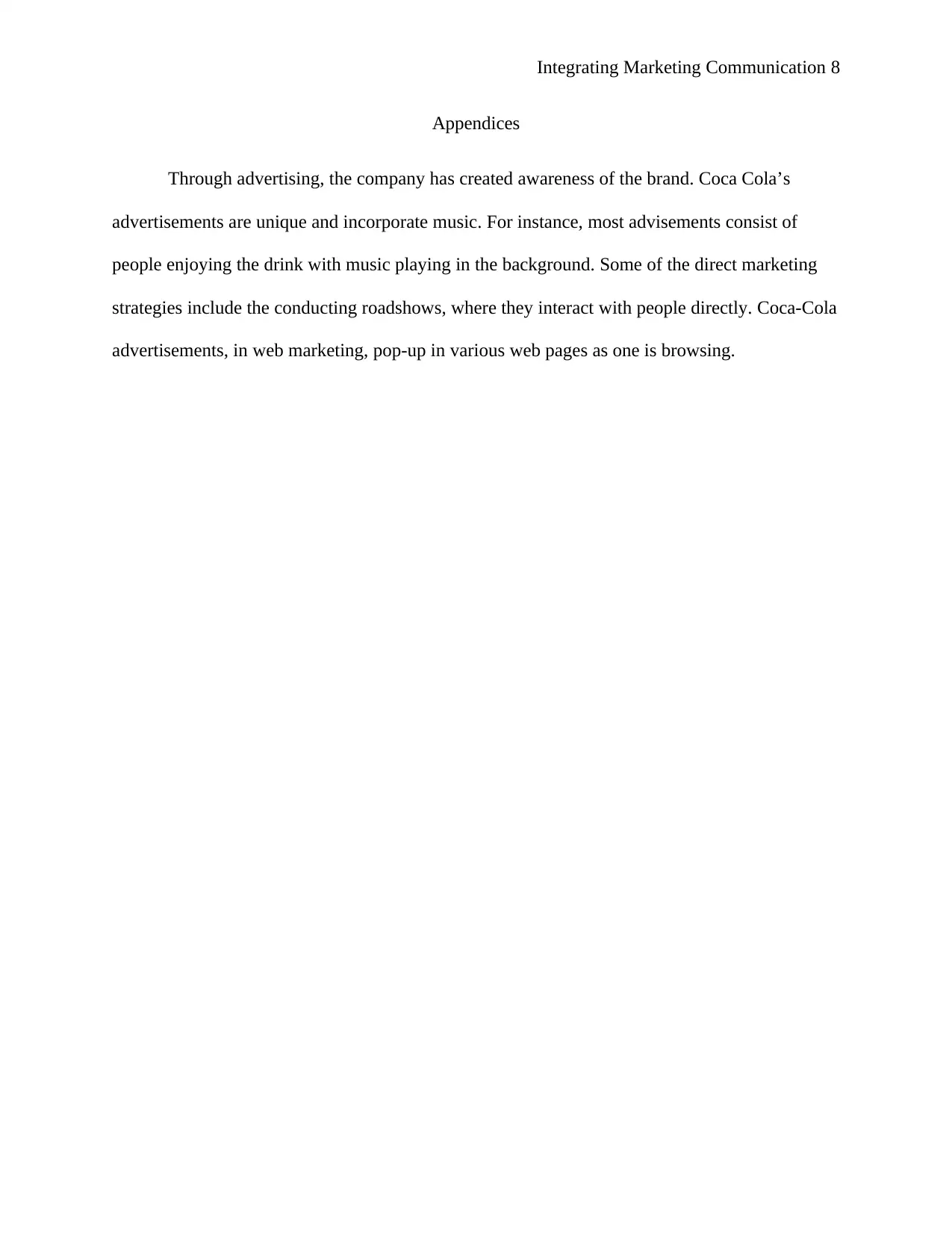
Integrating Marketing Communication 8
Appendices
Through advertising, the company has created awareness of the brand. Coca Cola’s
advertisements are unique and incorporate music. For instance, most advisements consist of
people enjoying the drink with music playing in the background. Some of the direct marketing
strategies include the conducting roadshows, where they interact with people directly. Coca-Cola
advertisements, in web marketing, pop-up in various web pages as one is browsing.
Appendices
Through advertising, the company has created awareness of the brand. Coca Cola’s
advertisements are unique and incorporate music. For instance, most advisements consist of
people enjoying the drink with music playing in the background. Some of the direct marketing
strategies include the conducting roadshows, where they interact with people directly. Coca-Cola
advertisements, in web marketing, pop-up in various web pages as one is browsing.
1 out of 8
Related Documents
Your All-in-One AI-Powered Toolkit for Academic Success.
+13062052269
info@desklib.com
Available 24*7 on WhatsApp / Email
![[object Object]](/_next/static/media/star-bottom.7253800d.svg)
Unlock your academic potential
Copyright © 2020–2025 A2Z Services. All Rights Reserved. Developed and managed by ZUCOL.





